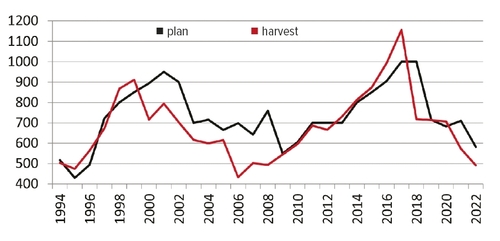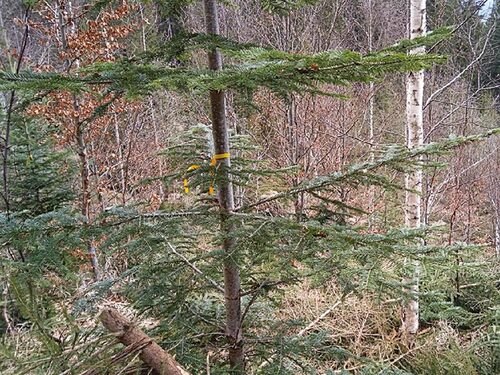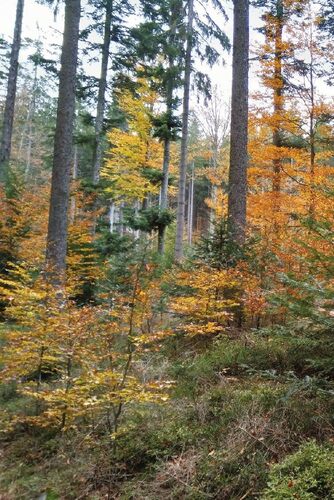Nature Conservation 2024 — 30. 5. 2024 — Nature and Landscape Management — Print article in pdf
Game Management in the Šumava/Bohemian Forest Mts. National Park

Since establishing the Šumava/Bohemian Forest Mts. National Park (hereinafter ŠNP) in 1991 game and its management have been an important part of forest management there. The first NP’s Management Plan (Kučera et al. 1992) dealt extensively with the issue. According to its authors, Red deer (Cervus elaphus) numbers were extremely high within the whole NP and keeping and breeding of trophy game was preferred. Moreover, it was clear at that time that due to red deer’s migratory behaviour its management should not be limited only to the NP’s territory but it should be connected with that on the entire Protected Landscape Area’s territory as well as with the whole Šumava/Bohemian Forest Mts. foothills including the Bavarian side.
Forest damage, game reduction
The 1992 management plan also regarded the condition of the forest stands as very bad due to damage caused by game. Forest regeneration was insufficient, and its failure due to game browsing was an essential risk to their survival in preserved remnants of old autochthonous stands. In addition to an increase in forest ecosystem resilience and stability, it was crucial for remediation to solve the red deer issue. It appeared to be necessary to reduce its numbers and to develop a special red deer management policy closely related to the environment (Kučera et al. l.c.).
Targeted forest management
The above issue is also related to forest management, which has been included a range of modern elements since the very establishment of the ŠNP, and could today be introduced into conceptual documents of any forest property (Kozel 2021a). For example, making full use of natural forest regeneration, supporting other tree species than Norway spruce (Picea abies) including pioneer species, maintaining the canopy open, applying selective logging, performing hunting according to forest stand condition instead of normed game population, and limiting the gamekeepers’ right of reductive cull. Since game management is an integral part of forest management in the ŠNP, tools increasing the ecological stability and carrying capacity of forest ecosystems were applied there.
Selection principles, hunting according to forest condition
Forest management has since the establishment of the ŠNP been based on the principles of ecologically justified forest management (Thomasius 1992). The age class forest model was abandoned, selective logging and selection principles are used, the European silver fir (Abies alba) and broad-leaved deciduous species are supported, just as natural regeneration, succession, and self-regulation are. As part of selective logging, also selection with variable intensity is used. Thanks to this, not only the forest condition has been considerably improved but also the carrying capacity for game animals and the habitat for grouse, particularly the Western capercaillie (Tetrao urogallus) and Hazel grouse (Tetrastes bonasia) (Kozel 2021). Enhancement was achieved by minimising game numbers and sophisticated game management. It was necessary to cull and reduce red deer strongly and to adapt hunting plans to the state of forest stands (Kučera et al. l.c.).
Practice has been delayed
Although the recommendations were formulated in 1992, it lasted several years before they were reflected in practice. Intensive hunting started only after the forests had been taken over from the previous managers (Military Forests and Farms of the Czech Republic, State Enterprise and Forests of the Czech Republic, State Enterprise) and new organisational structures and hunting grounds were formed. In as late as 1997, the harvest plan saw an increase to 625 red deer individuals, while a number of 430–517 individuals per year was planned for 1994–1996 (see Figure 1). In 1998, this number rose to 800 individuals and in 1999–2001 even to 950 individuals yearly. Because great emphasis was put on an active approach to hunting, the natural deer mortality was not included in the total number hunted. The harvest plans were ambitious and aimed at fulfilling the first Management Plan. Their implementation resulted in increased numbers of shot game, but harvest plans without natural mortality could generally not be achieved (see Figure 1).
Stagnation, decline, increase
After the peak in 1999 (911 specimens), hunting stagnated and declined (see Figure 1). In 2000–2002, approx. 704–794 red deer specimens were shot, while 900–950 individuals had been planned. Another decline occurred in 2003–2010, which probably resulted in an increase in the red deer number. Since 2012, great emphasis has again been put on reductive hunting and the harvest plan was raised to 1,000 individuals in 2017. That year has so far also been the year of the maximum in red deer hunting in the ŠNP’s history, when 1,156 red deer individuals were bagged there (see Figure 1). Since then, red deer harvest has declined. This has been caused by a number of factors, in addition to reduction in numbers and the high difficulty of hunting, also the effort to achieve the ŠNP and the Bayerischer Wald/Bavarian Forest National Park long-term goals, as well as the return of the Grey wolf (Canis lupus).

Figure 1 Monitoring nitrates in drip water in the Harbeš Cave and the Amaterská jeskyně/Amateurs Cave in 2018–2020. © Taťána Halešová
Overwintering facilities
The game management also includes a network of overwintering facilities, which uses the seasonal red deer migration in the Šumava/Bohemian Forest Mts. area. The concentration in these small parks for deer moving mainly from the ridges to the lower parts of the Šumava/Bohemian Forest Mts. has reduced the damage to forests stands on wintering grounds. These small gamekeeping forests/deer parks, 15 in total, were founded in 1999–2001 (Jirsa 2005). Another two were added in 2005 and 2011. There were two reasons for building them: reduction of damage at sites where red deer occurs in winter, and termination of seasonal migration out of the ŠNP territory (Šustr 2013). Today, ten overwintering facilities are functional, of which the two least used ones are expiring.
Game management in the Šumava/Bohemain Forest Mts. Management Principles
The present forest and game management in the ŠNP is based on a policy similar to the ones mentioned in the previous Management Plans. That is confirmed by the Šumava/Bohemian Forest Mts. National Park management principles. The policy (Anonymus 2022) is valid as of 2023, and highlights, inter alia, that game hunting and management are not based on a breeding approach, but has regulation of ungulate abundance as its main target in order to secure successful growth of broad-leaved deciduous trees and the European silver fir on the ŠNP territory. Hunting planning is based on the condition of the forest, taking into account game seasonal migration and the state of the natural predator population (the Grey wolf and the Eurasian lynx Lynx lynx – particularly especially their food/diet requirements). Therefore, the results of forest ecosystem monitoring are an important basis for the game management.
Results of forest management
The ŠNP Administration continually monitors the state and development of forest ecosystems. One of the sources is the large-scale forest survey (LFS, IFER 2020). Thanks to targeted changes in forest growths, which include game management, the structure of forest ecosystems has changed significantly (Kozel 2021c). Stands with a richer structure and mixed stands have increased at the expense of those with conifers and a horizontal canopy. The fact that more than 64% of the forest area regenerates under selective pressure of the maternal stand is also favourable. Regeneration is distributed mainly randomly and clustered, and occurs regularly in only 3% of cases.

Numbers of European silver fir and pioneer tree species in the Šumava/Bohemian Forest Mts. National Park regeneration stands have increased 5× in the past 20 years. © Jan Kozel

After 30 years, Šumava/Bohemian Forest Mts. National Park forests are considerably more diverse, partly thanks to the red deer population control. © Jan Kozel
Decrease in damage caused by game
According to the LFS results, also the damage caused by game has considerably declined. It decreased from 38 to 13% for Norway spruce and from 41 to 19% for European silver fir. The total browsing rate of leaders was 12% in 2019. Damage caused by barking and browsing have also gone down (IFER l.c.). This was confirmed by the results of detailed monitoring from 2018 to 2021 (Zenáhlíková & Červenka 2022). The monitoring of browsing caused by cloven-hoofed game has taken place in a regular network throughout the Šumava/Bohemian Forest Mts. National Park. In regenerating stands, the total browsing rate up to a height of 20 cm was 7.7%, in the category of 20–200 cm it was 20.7% (leader or lateral shoots) and 12.2% for the leaders only. The worst damaged trees were the Sycamore, also known as the Sycamore maple in the United States (Acer pseudoplatanus), Rowan or Whitebeam (Sorbus spp.), and other broad-leaved deciduous species. The damage varied significantly between forest management units (FMU). Most of it was concentrated in the České Žleby and Kašperské Hory FMUs. A comparison of the territory monitored in 2018 with the 2021 monitoring shows a significant decline in browsing damage. The average browsing rate of terminal shoots fell from 17.3% to 13.0% (Zenáhlíková & Červenka l.c.).
More fir, broad-leaved deciduous trees, and pioneer species
According to the LFS, the total extent of regeneration in the ŠNP increased by a factor of 2.3, the area of European silver fir by a factor of 5.4, pioneer trees by 4.4, and regenerating maples (Acer spp.) and elms (Ulmus spp.) increased by 3.6 between 1999 and 2019. The greatest change was seen with pioneer trees at elevations over 1,150 m a.s.l., where now 26 times more Sorbus and other pioneer species grow than in 1999. By contrast, European silver fir, European beech (Fagus sylvatica), and Sycamore increased most in places where the Šumava/Bohemian Forest Mts. forest should be the most diverse. There, at elevations up to 950 m a.s.l., we encounter fir and beech 10 times more often than in 1999, young Acer trees even 13 times. Fir thrives best at elevations of 950–1150 m a.s.l., where its share in regeneration changed from 1.7% to 5.2% (Kozel 2022). The cenotic position of the European silver fir in the ŠNP is also improved by spontaneous regeneration of other tree species. If the upper tree layer/canopy is missing, young fir is often accompanied by pioneer species, which contribute to a favourable growth (Kozel 2022). The representation of pioneer trees in regeneration in the ŠNP grew the most of all monitored species or species groups, from 6% to 12% over 20 years.
Wolves after 30 years
After more than 30 years of protection, conservation and management of ŠNP ecosystems including game management, it is evident that some of the proposals from planning documents of the ŠNP’’s beginning have been fully implemented. Adequate forest and game management has helped the forests to become more diverse and nutritious, and significantly less damaged by game (Kozel 2021b). The sex ratio in the red deer population is balanced (Tourani et al. 2023). Thanks to the return of prey animals, the original ecological relationships (red deer x grey wolf) are reestablished there. The permanent presence of wolves and their predation pressure change red deer behaviour, contributes to a control of their population, and makes hunting difficult. This is however not a reason to stop hunting activities, because also many other factors essential for the further NP management have changed.
Long-term goals, warming
The 2017 amendment to Act No. 114/1992 Gazette on Nature Conservation and Landscape Protection defined the long-term goal of Czech National Parks, i.e. an undisturbed course of natural events in their natural dynamics on the vast majority of NP’s territory. This has increased the area where hunting is banned and also the area where hunting is practically impossible. Hunting is much more difficult to practise than in the past, and will become even more complicated or impossible in a larger area than today. Another significant change is the different course of red deer seasonal migration due to climate change. Climate warming and the shortening of depth and duration of snow cover extends the time during which part of red deer stays at the highest elevations of the Šumava/Bohemian Forest Mts. The beginning of winter, and with it the arrival of game at lower elevations, is postponed by up to several weeks.
What about the small gamekeeping forests/deer parks?
The network of small gamekeeping forests/deer parks for overwintering has thus not been anymore so effective as in the past. The very existence of these facilities, which are probably morally obsolete, can also be questioned. They influence the migration, dispersal and behaviour of the red deer population, which is used to regular winter feeding. Its natural behaviour changes, and at the same time mortality declines, while fitness and natality increase. The concentration of game high numbers in fenced areas also interferes with the behaviour of predators, particularly wolves. They naturally seek for site where game occurs together and try to prey on them in small gamekeeping forests/deer parks. Moreover, as mild winters occur more often, the animals are not forced to look for alternative (artificial supplementary) food sources, so they come to the small gamekeeping forests/deer parks in lower numbers. Further, the number of visitors to the ŠNP has increased significantly. Visitors disturb the game, making it also more difficult to hunt the animals.
Unifying the approach and collaboration
All the above facts must be taken into consideration and included into the emerging game management concept. First of all, however, it is now necessary more than ever before to be coherent in the whole of the Protected Landscape Area, or even better in the whole Šumava/Bohemian Forest Mts. foothills including the Bavarian side. With respect to the red deer mobility, dispersal and seasonal migration, a successful future will mainly depend on coordination with the area outside the Šumava/Bohemian Forest Mts. National Park border. The Šumava/Bohemian Forest Mts. in a broader sense is an important habitat, for red deer as well as other animals, and not only forests and hunting grounds are under ŠNP management there. The Šumava Natural Forest Area covers 211,281 ha (ÚHÚL 2022). With its 69,000 ha, the ŠNP makes up one third (32.7%) of this. If the local game management is to be effective in the coming years, the approach needs to be similar to that in most of the ŠNP over the previous 30 years, and should moreover respond timely and adequately to the new reality. This should include a unified approach in the entire Šumava/Bohemian Forest Mts., regardless of any boundaries. ■
- - - -
The list of references is attached to the online version of the article at www.casopis.ochranaprirody cz
- - - -
Cover photo:
After establishment of the Šumava/Bohemian Forest Mts. National Park, European silver fir and broad-leaved deciduous trees hardly regenerated due to red deer overpopulation. © Jan Kozel

